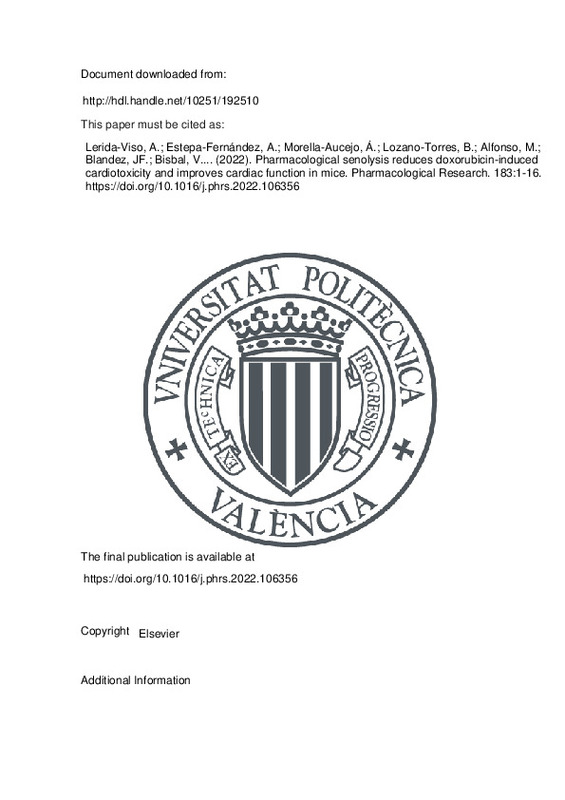JavaScript is disabled for your browser. Some features of this site may not work without it.
Buscar en RiuNet
Listar
Mi cuenta
Estadísticas
Ayuda RiuNet
Admin. UPV
Pharmacological senolysis reduces doxorubicin-induced cardiotoxicity and improves cardiac function in mice
Mostrar el registro sencillo del ítem
Ficheros en el ítem
| dc.contributor.author | Lerida-Viso, Araceli
|
es_ES |
| dc.contributor.author | Estepa-Fernández, Alejandra
|
es_ES |
| dc.contributor.author | Morella-Aucejo, Ángela
|
es_ES |
| dc.contributor.author | Lozano-Torres, Beatriz
|
es_ES |
| dc.contributor.author | Alfonso, María
|
es_ES |
| dc.contributor.author | Blandez, Juan F.
|
es_ES |
| dc.contributor.author | Bisbal, Viviana
|
es_ES |
| dc.contributor.author | Sepúlveda, Pilar
|
es_ES |
| dc.contributor.author | García-Fernández, Alba
|
es_ES |
| dc.contributor.author | Orzáez, Mar
|
es_ES |
| dc.contributor.author | Martínez-Máñez, Ramón
|
es_ES |
| dc.date.accessioned | 2023-03-15T19:00:53Z | |
| dc.date.available | 2023-03-15T19:00:53Z | |
| dc.date.issued | 2022-09 | es_ES |
| dc.identifier.issn | 1043-6618 | es_ES |
| dc.identifier.uri | http://hdl.handle.net/10251/192510 | |
| dc.description.abstract | [EN] Many anticancer agents used in clinics induce premature senescence in healthy tissues generating accelerated aging processes and adverse side-effects in patients. Cardiotoxicity is a well-known limiting factor of anticancer treatment with doxorubicin (DOX), a very effective anthracycline widely used as antitumoral therapy in clinical practice, that leads to long-term morbidity and mortality. DOX exposure severely affects the population of cardiac cells in both mice and human hearts by inducing premature senescence, which may represent the molecular basis of DOX-induced cardiomyopathy. Here, we demonstrate that senescence induction in the heart contributes to impaired cardiac function in mice upon DOX treatment. Concomitant elimination of senescent cells with the senolytic Navitoclax in different formulations produces a significant decrease in senescence and cardiotoxicity markers together with the restoration of the cardiac function in mice followed by echocardiography. These results evidence the potential clinical use of senolytic therapies to alleviate cardiotoxicities induced in chemotherapy-treated patients. | es_ES |
| dc.description.sponsorship | R.M. laboratory members thank the financial support from the Spanish Government projects RTI2018-100910-B-C41 and RTI2018-101599-B-C22 (MCUI/FEDER, EU)) and the Generalitat Valenciana (project PROMETEO 2018/024). M.O. thanks the financial support from the Spanish Government project (PID2020-115048RB-I00) and the Generalitat Valenciana (project PROMETEO/2019/065). A. L-V. is grateful to the Instituto de Salud Carlos III for her Ph.D. i-PFIS grant (IFI17/00039). A.E-F. and B.L.-T thanks to the Spanish Government for their Ph.D. grant (FPU17/05454) and (FPU15/02707). J.B. thanks to the Instituto de Salud Carlos III for his Sara Borrell contract (CD19/00038). M.A. thanks her postdoctoral fellowship (PAID-10-17). The funders had no role in the design, data collection, decision to publish, or preparation of the manuscript. The authors thank Alberto Hernandez for confocal microscopy, Alicia Martinez for flow cytometry, and Laura Ramirez for genomics guidance. The authors thank for the use of Biorender.com. | es_ES |
| dc.language | Inglés | es_ES |
| dc.publisher | Elsevier | es_ES |
| dc.relation.ispartof | Pharmacological Research | es_ES |
| dc.rights | Reconocimiento - No comercial - Sin obra derivada (by-nc-nd) | es_ES |
| dc.subject | Doxorubicin | es_ES |
| dc.subject | Cardiac senescence | es_ES |
| dc.subject | Senolytic | es_ES |
| dc.subject | Navitoclax | es_ES |
| dc.subject | Nanoparticles | es_ES |
| dc.subject | Prodrug | es_ES |
| dc.subject.classification | QUIMICA INORGANICA | es_ES |
| dc.title | Pharmacological senolysis reduces doxorubicin-induced cardiotoxicity and improves cardiac function in mice | es_ES |
| dc.type | Artículo | es_ES |
| dc.identifier.doi | 10.1016/j.phrs.2022.106356 | es_ES |
| dc.relation.projectID | info:eu-repo/grantAgreement/AEI/Plan Estatal de Investigación Científica y Técnica y de Innovación 2017-2020/PID2020-115048RB-I00/ES/EL INTERACTOMA DE MEMBRANA DE LAS PROTEINAS DE LA FAMILIA BCL-2 COMO DIANA ANTITUMORAL/ | es_ES |
| dc.relation.projectID | info:eu-repo/grantAgreement/UPV//PAID-10-17/ | es_ES |
| dc.relation.projectID | info:eu-repo/grantAgreement/AEI/Plan Estatal de Investigación Científica y Técnica y de Innovación 2017-2020/RTI2018-100910-B-C41/ES/MATERIALES POROSOS INTELIGENTES MULTIFUNCIONALES Y DISPOSITIVOS ELECTRONICOS PARA LA LIBERACION DE FARMACOS, DETECCION DE DROGAS Y BIOMARCADORES Y COMUNICACION A NANOESCALA/ | es_ES |
| dc.relation.projectID | info:eu-repo/grantAgreement/GVA//PROMETEO%2F2018%2F024//Sistemas avanzados de liberación controlada/ | es_ES |
| dc.relation.projectID | info:eu-repo/grantAgreement/AEI/Plan Estatal de Investigación Científica y Técnica y de Innovación 2017-2020/RTI2018-101599-B-C22/ES/DESARROLLO Y APLICACION DE SISTEMAS ANTIMICROBIANOS PARA LA INDUSTRIA ALIMENTARIA BASADOS EN SUPERFICIES FUNCIONALIZADAS Y SISTEMAS DE LIBERACION CONTROLADA/ | es_ES |
| dc.relation.projectID | info:eu-repo/grantAgreement/GVA//PROMETEO%2F2019%2F065/ | es_ES |
| dc.relation.projectID | info:eu-repo/grantAgreement/MECD//FPU15%2F02707/ES/FPU15%2F02707/ | es_ES |
| dc.relation.projectID | info:eu-repo/grantAgreement/ISCIII//IFI17%2F00039//i-PFIS grant/ | es_ES |
| dc.relation.projectID | info:eu-repo/grantAgreement/ISCIII//CD19%2F00038/ | es_ES |
| dc.relation.projectID | info:eu-repo/grantAgreement/MECD//FPU17%2F05454//AYUDA CONTRATOS PREDOCTORALES FPU-ESTEPA FERNANDEZ. PROYECTO: NUEVOS MATERIALES HIBRIDOS PARA LA ELIMINACION DE CELULAS SENESCENTES EN MODELOS DE ENFERMEDAD/ | es_ES |
| dc.rights.accessRights | Abierto | es_ES |
| dc.contributor.affiliation | Universitat Politècnica de València. Escuela Técnica Superior de Ingenieros Industriales - Escola Tècnica Superior d'Enginyers Industrials | es_ES |
| dc.description.bibliographicCitation | Lerida-Viso, A.; Estepa-Fernández, A.; Morella-Aucejo, Á.; Lozano-Torres, B.; Alfonso, M.; Blandez, JF.; Bisbal, V.... (2022). Pharmacological senolysis reduces doxorubicin-induced cardiotoxicity and improves cardiac function in mice. Pharmacological Research. 183:1-16. https://doi.org/10.1016/j.phrs.2022.106356 | es_ES |
| dc.description.accrualMethod | S | es_ES |
| dc.relation.publisherversion | https://doi.org/10.1016/j.phrs.2022.106356 | es_ES |
| dc.description.upvformatpinicio | 1 | es_ES |
| dc.description.upvformatpfin | 16 | es_ES |
| dc.type.version | info:eu-repo/semantics/publishedVersion | es_ES |
| dc.description.volume | 183 | es_ES |
| dc.identifier.pmid | 35843569 | es_ES |
| dc.relation.pasarela | S\469029 | es_ES |
| dc.contributor.funder | Generalitat Valenciana | es_ES |
| dc.contributor.funder | Instituto de Salud Carlos III | es_ES |
| dc.contributor.funder | Agencia Estatal de Investigación | es_ES |
| dc.contributor.funder | European Regional Development Fund | es_ES |
| dc.contributor.funder | Universitat Politècnica de València | es_ES |
| dc.contributor.funder | Ministerio de Educación, Cultura y Deporte | es_ES |







![[Cerrado]](/themes/UPV/images/candado.png)

